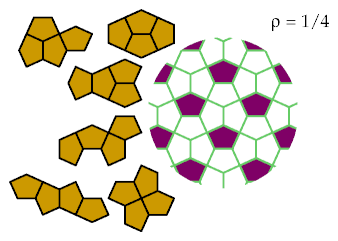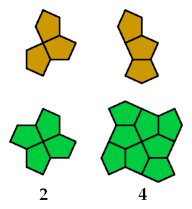Polycairo Exclusion
Introduction
In the 1950s, Solomon W. Golomb investigated the question:
how few cells can you remove from the plane
to exclude the shape of a given polyomino?
Here I investigate the related question:
how few cells can you remove from the plane
to exclude the shape of a given polycairo?
If you find a more efficient exclusion, please write.
Specific Results
Here are some patterns for small polycairos.
To exclude either dicairo you must remove at least 1/2 the cells.
This also holds for the two tricairos:


These tricairos are excluded optimally.
The tetracairos are probably optimal.



This pattern optimally excludes six tetracairos:

This pattern optimally excludes three tetracairos:

These tetracairos are optimally excluded by these patterns:


These patterns are the best known for excluding these tetracairos:


General Results
If a polycairo with n cells tiles the plane,
you must remove at least 1/n of the cells, one for each tile.
Optimality Proofs
The next diagram demonstrates the optimality of two of the exclusions
with more than 1/n holes.
The numbers show how many holes you need in the green figure
to exclude the yellow figure:

Last revised 2018-05-28.
Back to Polyform Exclusion, Equalization,
Variegation, and Integration
<
Polyform Curiosities
Col. George Sicherman
[ HOME
| MAIL
]












